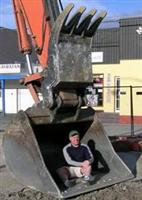

|
Penticton has been lucky in the last two years to have had, thanks to “Frank” The Baggage Handler and his detractors, a buzz of dialogue about local art installations. There is no shortage of opinions on Frank and other works around town, and the term "installation art" gets tossed around in the discussion quite a bit. But few pause to consider just what we mean by "installation art".
Figuring it out is not straightforward, and perhaps not even possible. But we can try to pin it down a little bit by looking at some basic ideas and some examples from Penticton.
Cezanne’s Still Life with Apples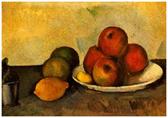
|
One characteristic that distinguishes an installation piece from a conventional one is the degree to which it involves the viewer. For example, imagine yourself looking at a conventional painting of, say, a bowl o' fruit. It hangs on the wall while you stand there and admire it. To some extent it involves you in that you can observe it at a distance or close up. You might also interpret it in various ways in your mind. But that's about it. It has its place (hanging on the wall) and you have yours.
Hermesh’s The Baggage Handler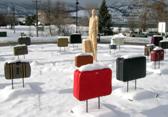
|
Contrast this with former Penticton roundabout resident, The Baggage Handler. Not only could you observe him close-up or far away, but also from a full 360° perspective, his appearance changing with each aspect. But your involvement goes beyond that. Recall that, during his roundabout tenure, Frank was surrounded by baggage. To get a better look at him you had to wander through and among various types of coloured suitcases. At that point you were no longer a detached viewer of the work. You're involved, because you're right inside it!
Smash #2, SuperValu Redux Exhibit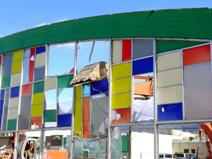
|
Another local example of installation and non-installation art combined was SuperValu Redux, an exhibit at Leir House Cultural Centre in the spring of 2006. The photographs of the former grocery store and its demolition hang on the walls and involve you in the conventional way. Interspersed with the photos are artefacts, some weighing several hundred pounds, of the original SuperValu structure. You can walk around them and see them from all angles, and touch and smell them for a fuller sensory experience.
Shear Plates, SuperValu Redux Exhibit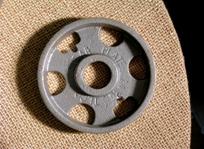
|
While involving yourself in the exhibit, you can also ponder ideas. Four months ago this stuff was still part of a building. Was it art then? Did it only become art when it was installed as an exhibit? Is it art at all?? These sorts of things you have to answer yourself. In creating the installation the artist's goal isn't to spoon-feed you answers. It's to involve you, and make you think.
|
SuperValu Anchors, SuperValu Redux Exhibit 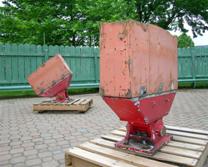
|
Installation art is also characterized by its temporary quality. Like Frank, the other roundabout installations that follow will only occupy the location for a fixed period of time. Then they disappear, either to be permanently dismantled, or perhaps reassembled in a new location. Unlike a conventional sculpture or painting, an installation might also be dynamic. The SuperValu Redux installation component was dynamic in that the pieces changed position every few days. It's also temporary – in fact it has already been dismantled!
In the summer of 2006 a new work appeared in the Penticton roundabout. "Starship" by Tim McElderry was the third in the series of roundabout installations. While it’s in place, be sure to examine it from afar, and up close, and from many different angles. Look at it by day and by night, in sun and in rain. Touch it and feel it. Or imagine doing so while you view it online. That way you will have got fully involved in experiencing the art, well beyond what you would get from the painting of a bowl o' fruit.
References:
Installation Art http://en.wikipedia.org/wiki/Installation_art
When is a room not a room? http://www.guardian.co.uk/saturday_review/story/0,,604711,00.html
|
|
SuperValu Redux – an evocation of the edifice – was on display at Leir House in Penticton in the spring of 2006. Be sure to check out the online exhibit.